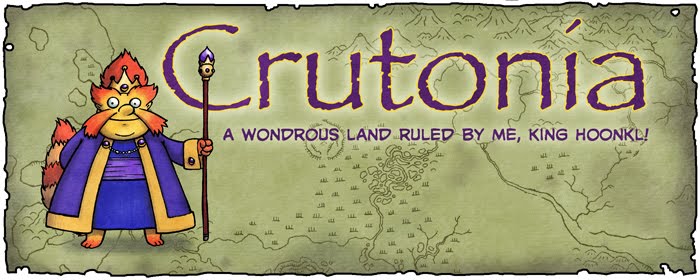
Crutonia has a number of wonderful forests. One of these is the Bungal Forest, which is a wide swath of forest stretching from the Crutonian Bay to the Western end of the Zigzanthium Mountains, and from the central plains to Mandrian Lake.
The Bungal Forest has several interesting sub-regions including the Bungal Downs, Praggle Pit and the Jumbit Woods. The Bungal Downs contain small, rolling hills, with the city of Bungaliville at the most Southern edge. The downs are slightly elevated, providing a dryer area in comparison to the swampland and river terrain located proximally to it.
Bungaliville is a large settlement on the bank of the Mandrian Lake, with modified Cruton-style mushroom architecture containing tall towers and numerous balconies. The town is populated by bungali, with equal numbers of other city creatures that include bordaden, braxxon, and shemoybl. Bungalliville is one of my larger trade and manufacturing cities, producing refined sugar and confections, pottery, and a number of other products. With fine restaurants and inns, the city is also a popular tourist destination. I do enjoy a holiday within this fine town!

Another feature found in the Bungal Forest is Praggle Pit, an ancient rocky crater that has become overgrown with plant life. Praggle Pit is home to a significant number of scabee, thereby making this a dangerous region. These creatures are quite a vicious horror, I will have to make a separate post on them.
The Jumbit Woods is located in the Northeast corner of the Bungal Forest, and is more densely overgrown in comparison to the rest of the Forest most notably due to the presence of Jumbit trees. The foliage of the jumbit tree forms a tangled lattice, creating a terrain that is difficult to traverse. This part of the forest is a bit of a labyrinth, with dark spaces created by the entangled vine-like branches. This maze provides shelter to native creatures such as the jumfum but can lead to unprepared travelers becoming quite lost.
Several very interesting citizens live within the Bungal Forest, most of which reside in the town on Bungaliville. Others include the zoobotanist Tzopatz, who lives in a tree house on the Northern edge of the Bungal Forest. She lives in general isolation so she can concentrate on her work, which includes flora-fauna grafting.
In addition to the city of Bungaliville, there is another town within the forest, the eta colony Fjnkswell. This town is known as the ship-building center of the Bay, and is a main post for travelers to and from the Crutonian Bay islands.


 cabee named Ogsmuck the Hideous. Smakubak taught this scabee to appreciate a good yarn. The scabees of the tribe now are descendants of Ogsmuck, and they all have learned to appreciate stories and not to attack creatures that could tell them a good tale. It is not a free pass, though; if the creatures could not tell them a good enjoyable story, the scabees are free to devour them as they naturally please.
cabee named Ogsmuck the Hideous. Smakubak taught this scabee to appreciate a good yarn. The scabees of the tribe now are descendants of Ogsmuck, and they all have learned to appreciate stories and not to attack creatures that could tell them a good tale. It is not a free pass, though; if the creatures could not tell them a good enjoyable story, the scabees are free to devour them as they naturally please.




















 of Crutonia’s larger settlements, and has modified Cruton-style mushroom architecture, with tall towers and balconies. The residents are a mix of different creatures as is typical of my larger towns, but with a majority of Bungalians being bungali. The architecture really suits the bungali, with their fondness for skirt gliding. The good citizens of Bungaliville specialize in the manufacture of a number of important exports, such as refined sugar and confections, conshabrine, wailer oil, as well as the tourist and entertainment trade. Bungaliville is a truly delightful place
of Crutonia’s larger settlements, and has modified Cruton-style mushroom architecture, with tall towers and balconies. The residents are a mix of different creatures as is typical of my larger towns, but with a majority of Bungalians being bungali. The architecture really suits the bungali, with their fondness for skirt gliding. The good citizens of Bungaliville specialize in the manufacture of a number of important exports, such as refined sugar and confections, conshabrine, wailer oil, as well as the tourist and entertainment trade. Bungaliville is a truly delightful place


















